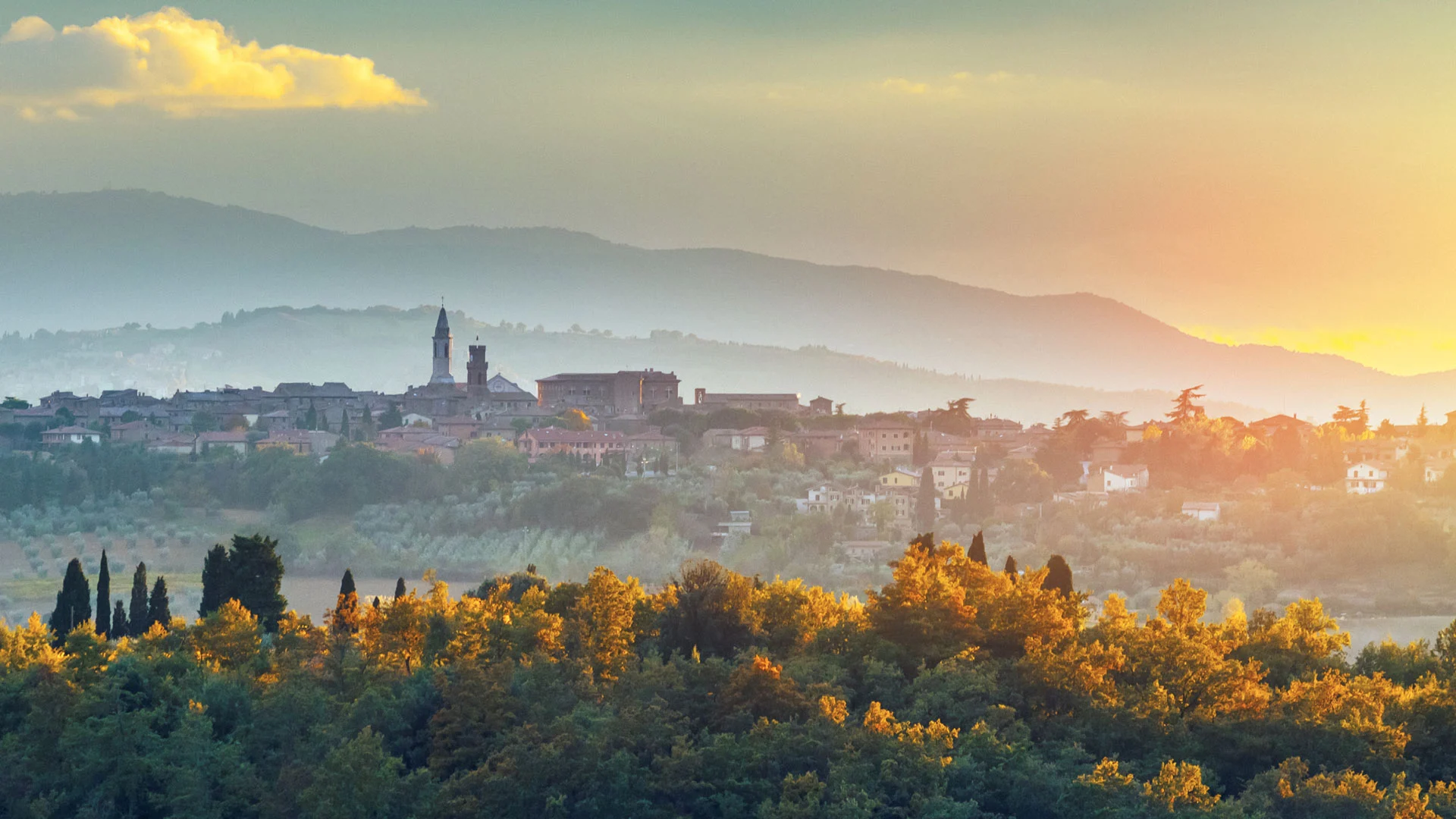托斯卡纳的皮恩扎镇, 意大利 Town of Pienza in Tuscany, Italy (© zpagistock/Getty Images)
托斯卡纳的皮恩扎镇, 意大利 Town of Pienza in Tuscany, Italy (© zpagistock/Getty Images)
品味皮恩扎 A taste of Pienza
托斯卡纳的皮恩扎镇, 意大利
有些城镇历经数个世纪缓慢演变。皮恩扎?15世纪,一位教皇为了证明某种观点——或许也为了炫耀——彻底重塑了它。这座意大利小镇坐落在奥尔恰山谷之上,周围环绕着连绵起伏的群山,其景象与你想象中的托斯卡纳一模一样:柏树成荫,蜿蜒的土路,偶尔还能看到几只绵羊。它宁静祥和。而当你踏入城墙,它便会变得灵动起来。
皮恩扎曾是一个普通的中世纪村庄,名叫科尔西尼亚诺。直到教皇庇护二世的儿子决定改造他的家乡,他聘请了建筑师贝尔纳多·罗塞利诺,按照文艺复兴时期的对称、秩序与和谐理念重建了这片区域。结果如何?这片区域仿佛是经过精心设计的。中心广场皮奥二世广场两侧分别矗立着大教堂、教皇宫殿和市政厅,布局也恰到好处。此外,皮恩扎还以佩科里诺奶酪而闻名——这是一种以羊奶为原料,以独特的方式陈酿而成的奶酪。每年一次,整个小镇都会变成奶酪竞技场,举办“奶酪节”(Fiera del Cacio),这是一个以“奶酪轮”(Cacio al Fuso)为特色的节日——这是一种人们将奶酪轮滚向目标的游戏。
The town of Pienza in Tuscany, Italy
Some towns evolve slowly over centuries. Pienza? It received a full rebrand in the 1400s from a pope who wanted to prove a point—and maybe show off a little. This tiny Italian town is perched above the Val d'Orcia, surrounded by rolling hills that look exactly like you think Tuscany should: cypress trees, winding dirt roads, the occasional sheep. It's peaceful. And then you step inside the town walls, and it gets clever.
Pienza was once a regular medieval village called Corsignano. That is, until one of its sons became Pope Pius II and decided to transform his hometown. He hired architect Bernardo Rossellino and rebuilt the area based on Renaissance ideals of symmetry, order, and harmony. The result? A site that feels intentional. The central square, Piazza Pio II, is flanked by a cathedral, a papal palace, and a town hall, all arranged just so. Moreover, Pienza is known for pecorino cheese—sheep's milk, aged in interesting ways. And once a year, the whole town turns into a cheese arena for Fiera del Cacio, a festival featuring Cacio al Fuso—a game where people roll wheels of cheese at a target.
阿尔贝罗贝洛的特鲁洛建筑,普利亚大区,意大利 Trullo buildings in Alberobello, Apulia, Italy (© Feng Wei Photography/Getty Images)
阿尔贝罗贝洛的特鲁洛建筑,普利亚大区,意大利 Trullo buildings in Alberobello, Apulia, Italy (© Feng Wei Photography/Getty Images)
一座非凡的特鲁洛小镇 A 'trulli' remarkable town
阿尔贝罗贝洛的特鲁洛建筑,意大利
如果童话故事里有建筑师,他们或许能创造出像意大利阿尔贝罗贝洛那样的景象。但这座小镇的标志性建筑——特鲁利(trulli,单数为trullo),并非靠魔杖,而是石灰岩、无砂浆砌筑,以及——根据某些理论——一些逃税手段——才得以建成。这些粉刷过的石屋顶部是干砌的石灰岩屋顶,形状像倒置的冰淇淋蛋筒。这是一种古老的建筑技术,在阿尔贝罗贝洛,更是巧妙之举。据说早在14世纪,当地人就试图通过建造房屋来逃避房产税,因为国王的税务官来袭时,这些房屋很容易被拆除。
阿尔贝罗贝洛的特鲁利并非孤例。像蒙蒂区(Rione Monti)和小阿亚区(Aia Piccola)这样的整个街区都挤满了这些奇特的建筑。有些至今仍有人居住,有些则被改造成咖啡馆、纪念品商店和小型博物馆。你甚至还能找到一座特鲁利风格的教堂。1996年,联合国教科文组织将阿尔贝罗贝洛的特鲁利列为世界遗产。一个漏洞成为地标建筑的情况并非每天都有。
Trullo buildings in Alberobello, Apulia, Italy
If fairy tales had architects, they might've come up with something like Alberobello in Italy. But instead of magic wands, it was limestone, mortar-free masonry, and—according to some theories—a bit of tax evasion that built this town's signature homes: the trulli. These are whitewashed stone houses topped with dry-stacked limestone roofs shaped like upside-down ice cream cones. It's an ancient building technique, and in this case, a clever one. Back in the 14th century, locals were reportedly trying to avoid property taxes by constructing homes that could be quickly dismantled when the king's tax collector came around.
Alberobello's trulli aren't hidden one-offs. Entire districts—like Rione Monti and Aia Piccola—are packed with these quirky structures. Some are still lived in, while others have been transformed into cafés, souvenir shops, and pint-sized museums. You'll even find a church built in trullo style. In 1996, UNESCO gave the trulli of Alberobello the heritage stamp of approval. It's not every day that a loophole becomes a landmark.
圣玛格达莱娜, 多洛米蒂山, 意大利 Village of Santa Maddalena, Dolomites, Italy (© Sakrapee Nopparat/Getty Images)
圣玛格达莱娜, 多洛米蒂山, 意大利 Village of Santa Maddalena, Dolomites, Italy (© Sakrapee Nopparat/Getty Images)
来自山巅的明信片 Postcard from the peaks
圣玛格达莱娜, 多洛米蒂山, 意大利
位于意大利北部阿尔卑斯山的南蒂罗尔州,圣玛格达莱娜村坐落于福内斯山谷中,宛如明信片上描绘的理想村落。村中标志性的尖顶教堂,背后耸立着刀削斧刻般的多洛米蒂山峰,是该地区最常被拍摄的景致之一。多洛米蒂山脉本身被联合国教科文组织列为世界遗产,山体主要由淡色石灰岩构成,日落时泛起柔和的粉红色光芒,当地人称之为“日照粉红”现象。
圣玛格达莱娜村安静而质朴,深受拉丁语系与蒂罗尔传统文化影响。木屋星罗棋布地点缀在郁郁葱葱的山坡上,奶牛悠闲地在如画的牧场中吃草。尽管位置偏远,这里却是进入多洛米蒂核心徒步区域的门户,其中包括穿越普耶兹-奥德莱自然公园的热门步道。冬季,这里成为雪地健行和越野滑雪的宁静据点。游客来到此地,并非追求城市的喧嚣或热闹夜生活,而是为了静谧的氛围、壮丽的自然景观。圣玛格达莱娜村是自然与文化交融的典范,无需滤镜,自成风景。
Village of Santa Maddalena, Dolomites, Italy
Tucked into the northern Italian Alps, the village of Santa Maddalena is a postcard-perfect hamlet in South Tyrol's valley of Val di Funes. With its iconic church steeple set against the jagged peaks of the Dolomites—a mountain range in the Alps—it's one of the most photographed spots in the region. The Dolomites themselves—a UNESCO World Heritage Site—rise dramatically behind the village, their pale limestone faces glowing pink at sunset in a phenomenon locals call 'enrosadira.'
Santa Maddalena is small, quiet, and deeply rooted in local Ladin and Tyrolean traditions. Wooden chalets dot the green hills, and cows graze in meadows that seem painted into place. Although it feels remote, the village is a gateway to some of the Dolomites' best hiking, including trails through Puez-Odle Nature Park. In winter, it's a peaceful base for snowshoeing and cross-country skiing. Visitors come not for crowds or nightlife, but for silence, scenery, and a sense of timelessness. Santa Maddalena is where nature and culture meet in harmony—no filter needed.
梵蒂冈城与圣彼得大教堂,罗马,意大利 Vatican City with Saint Peter's Basilica (© RudyBalasko/Getty Images)
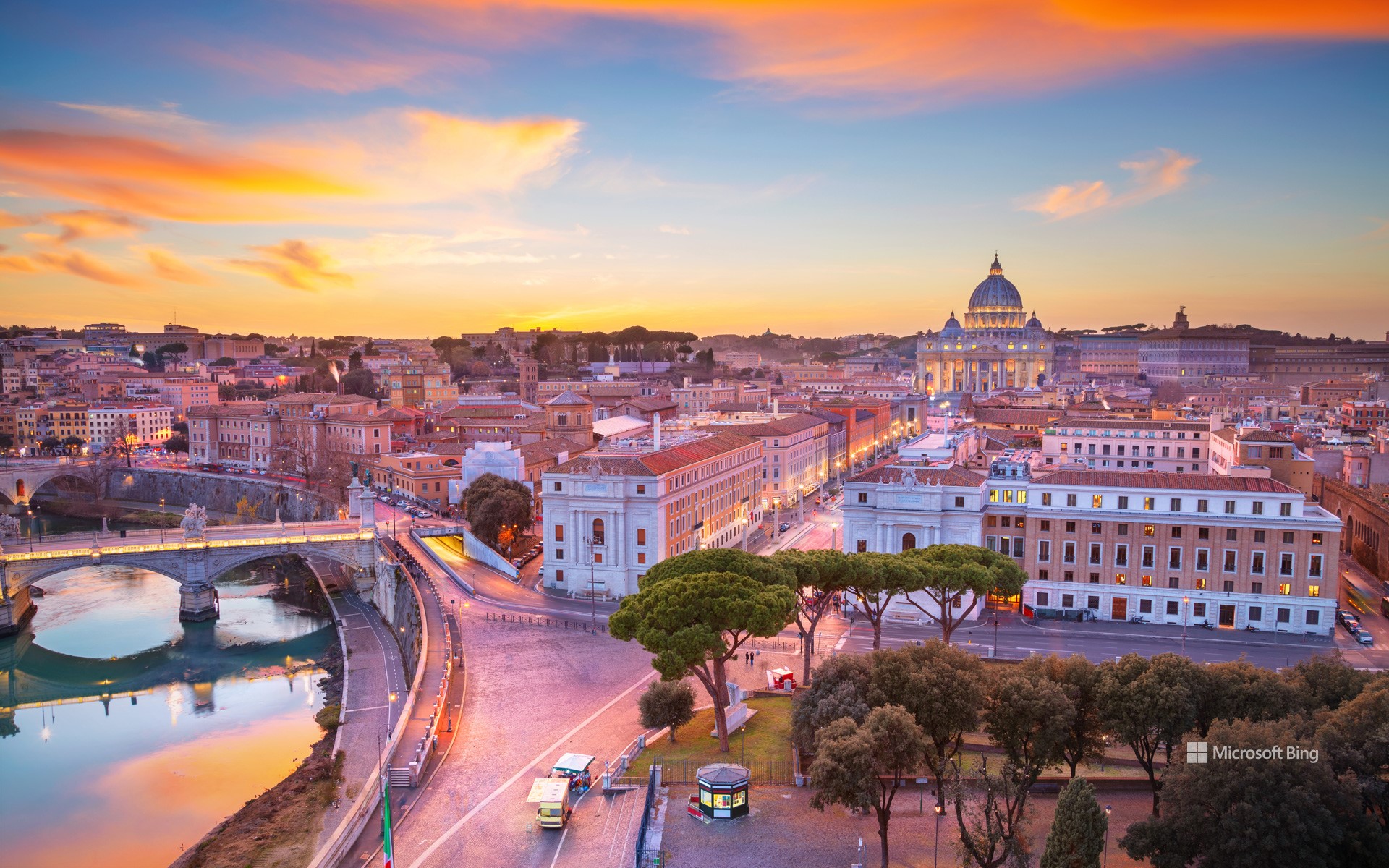
梵蒂冈城与圣彼得大教堂,罗马,意大利 Vatican City with Saint Peter's Basilica (© RudyBalasko/Getty Images)
城中之国 A country within a city
梵蒂冈城,罗马,意大利
在意大利罗马市中心,有一个独立的国家:梵蒂冈城国。这个国家仅有 121 英亩,是世界上最小的独立国家,但其影响力却跨越了数个世纪和各大洲。作为教皇的居所和罗马天主教的精神中心,这座城墙环绕的飞地融合了艺术、历史与信仰。梵蒂冈城的核心地标是圣彼得大教堂,这座文艺复兴时期的建筑被普遍认为建于耶稣门徒、第一任罗马主教圣彼得的安葬地之上。今日图片中远景所示即为其雄伟的穹顶,也是世界上最大的教堂之一。大教堂前的圣彼得广场是教皇祝福仪式和宗教聚会的重要场所,每年吸引大量信众前来朝圣。此外,梵蒂冈博物馆与西斯廷礼拜堂也是不可错过的文化遗产,后者天顶画由米开朗基罗绘制,堪称艺术巅峰。尽管面积狭小,梵蒂冈城国却拥有独立的行政体系,包括邮政、电话系统、银行以及货币发行权。它虽非欧盟成员国,却发行专属欧元硬币。
环绕着梵蒂冈城的是罗马这座城市,本身就是一座活着的博物馆,拥有斗兽场、古罗马广场、万神殿等历史地标。在这里,信仰、历史与现代交织,带来一段独特且难忘的体验。
Vatican City with St. Peter's Basilica
In the middle of Rome, Italy, lies an entire country of its own: Vatican City. At just 121 acres, it's the smallest independent nation in the world, yet its reach spans centuries and continents. Home to the pope and the spiritual center of the Roman Catholic Church, this walled enclave is a blend of art, history, and devotion. At its core stands St. Peter's Basilica. Seen in the distance in today's image, this Renaissance masterpiece is built over what is believed to be the tomb of St. Peter, the first bishop of Rome. With its soaring dome dominating the skyline, the basilica is one of the largest churches in the world. Just beyond the basilica lies St. Peter's Square, where thousands gather for papal blessings. The Vatican Museums and the Sistine Chapel, which houses Michelangelo's famed ceiling, are other must-sees. Despite its size, Vatican City has its own postal service, telephone system, and banking system.
塞切达,多洛米蒂山脉的山峰,南蒂罗尔,意大利 Seceda, a peak in the Dolomites, South Tyrol, Italy (© Kalyakan/Adobe Stock)

塞切达,多洛米蒂山脉的山峰,南蒂罗尔,意大利 Seceda, a peak in the Dolomites, South Tyrol, Italy (© Kalyakan/Adobe Stock)
锋芒毕露的美 Beauty with an edge
塞切达,多洛米蒂山脉的山峰,南蒂罗尔,意大利
意大利多洛米蒂山脉不仅雄伟耸立,更如施展魔法般,使每一条山路都变成一个故事。人们亲切地称它们为“苍白山脉”,这一名字源自其主要构成矿物白云石。这片山脉坐落于意大利北部阿尔卑斯山脉,占地超过34.5万英亩,拥有18座海拔超过9,500英尺的高峰。其地貌特征包括陡峭的悬崖、雄伟的岩壁和蜿蜒狭窄的山谷。
在多洛米蒂山的壮丽景色之中,坐落着其最壮观的山峰之一塞切达,正是今日图中所示。它海拔约8200英尺,是南蒂罗尔省瓦尔加迪纳山谷中最高的全景观景台。乘坐缆车即可轻松抵达山顶,省去原本艰难的登山行程。登顶之后,映入眼帘的是多洛米蒂山标志性的锯齿状山脊线的壮丽全景。在晴朗的日子里,甚至可以远眺90多英里外的奥地利最高峰格洛克纳山。
Seceda, Dolomites, South Tyrol, Italy
Italy's Dolomites don't just tower; they enchant, turning every trail into a story. Fondly known as the 'Pale Mountains,' the Dolomites derive their name from dolomite—a carbonate mineral. Set in the northern Italian Alps, the range spans over 345,000 acres and boasts 18 soaring peaks that rise above 9,500 feet. These mountains feature sheer cliffs, lofty walls, and a maze of narrow, winding valleys.
Amid the dramatic landscape of the Dolomites lies one of its most spectacular peaks, Seceda, featured in today's image. With a height of around 8,200 feet, it offers the highest panoramic viewpoint in Val Gardena, a scenic valley in the province of South Tyrol. A short cable car ride takes you to the summit, bypassing what would otherwise be a strenuous hike. Once at the top, you're greeted by a stunning sweep of the Dolomites' iconic jagged ridgelines. On a clear day, you might even spot Austria's tallest mountain, the Großglockner, located more than 90 miles away.
奥罗塞,撒丁岛,意大利 Orosei, Sardinia, Italy (© EyeEm Mobile GmbH/Getty Images)
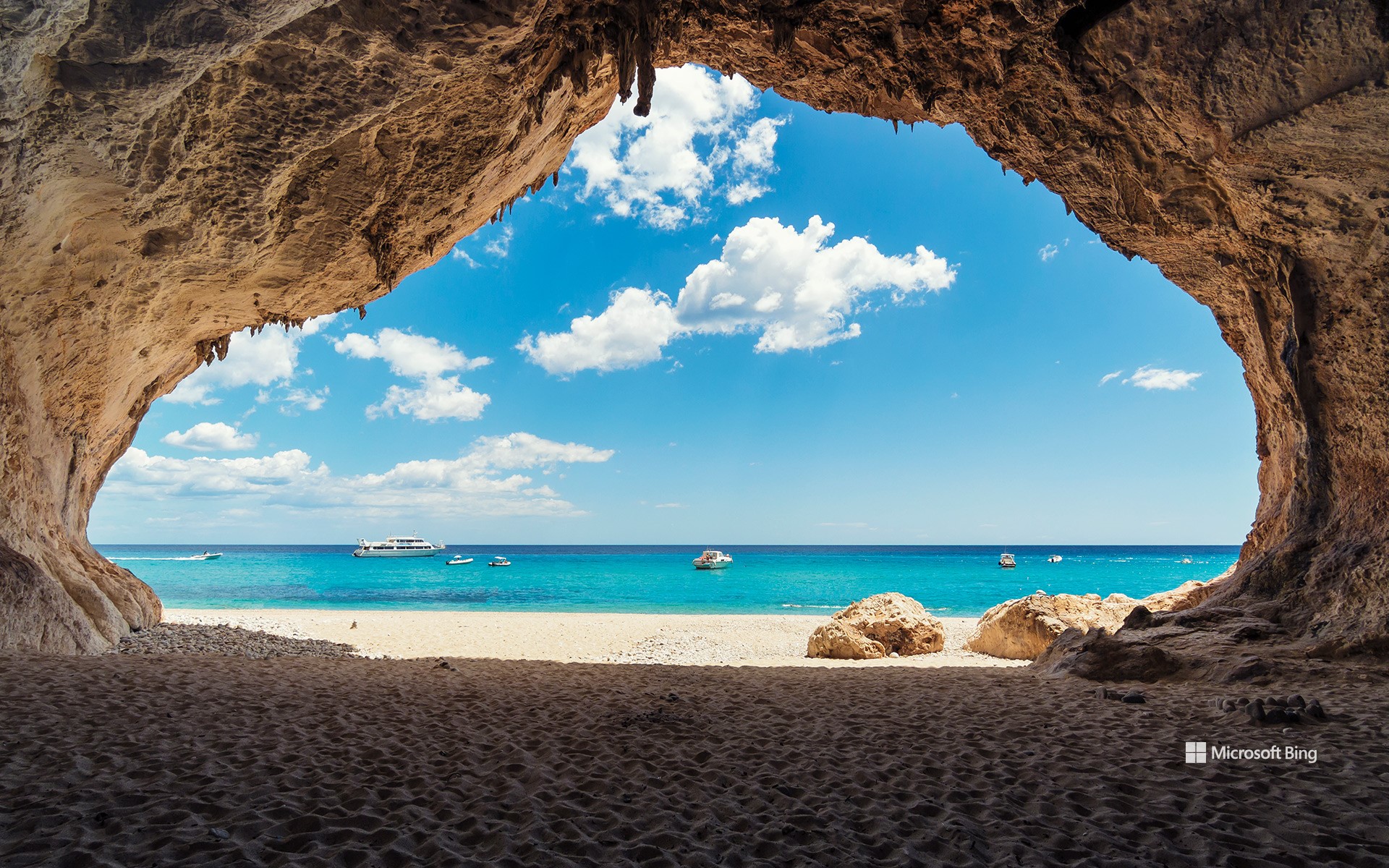
奥罗塞,撒丁岛,意大利 Orosei, Sardinia, Italy (© EyeEm Mobile GmbH/Getty Images)
水、空气、岩石 Water, Air, Rock
奥罗塞,撒丁岛,意大利
此刻,我们置身于意大利撒丁岛东部奥罗塞湾的一处瑰宝卡拉卢纳,坐落于第勒尼安海之滨。大自然在此将岩石雕琢成面向大海的隐秘洞穴,正如今日图片所示,湛蓝海水悄然渗入石窟,在石灰岩墙上投射出光影交织的图案。金色沙滩与天然阴影交错,地中海的微风带来咸香气息,海浪轻拍岩岸,低语着亘古不变的旋律。被岩洞环抱的这片海滩仿若人间秘境,陆地与海洋在此交汇,构成一幅和谐而独特的自然画卷。清澈海水邀请人们畅游其中,峭壁巍峨静立,见证岁月流转。卡拉卢纳不仅是一处地理位置,更是一段自然的诗篇:海浪拍击古老岩石的低语,金色阳光在水面上的短暂停留,共同诉说着海洋以超越语言的方式,留下的恒久故事。
五塔峰,多洛米蒂山脉,科尔蒂纳丹佩佐,贝卢诺省,意大利威尼托大区 Cinque Torri, Dolomites, Italy (© usabin/Getty Images)
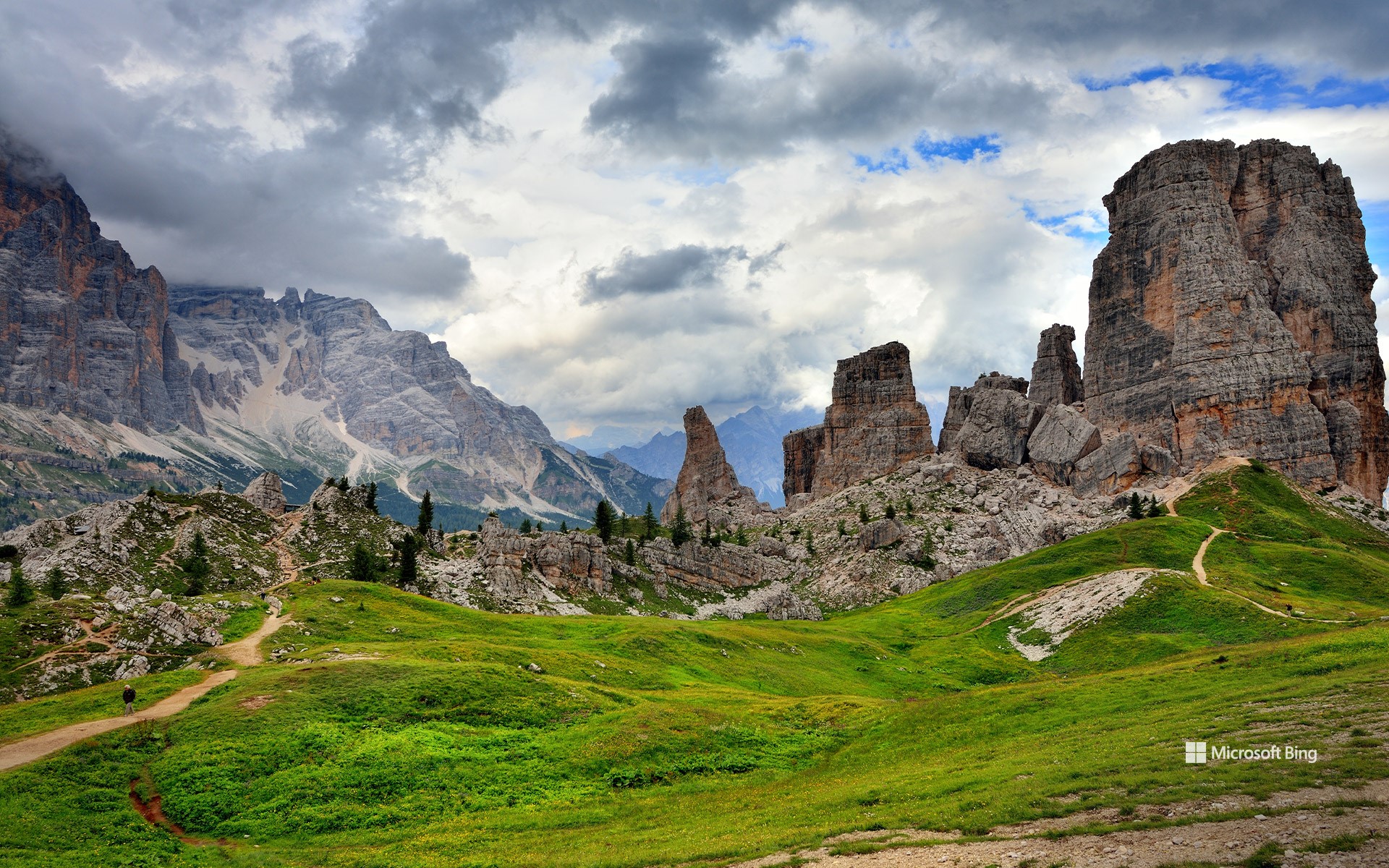
五塔峰,多洛米蒂山脉,科尔蒂纳丹佩佐,贝卢诺省,意大利威尼托大区 Cinque Torri, Dolomites, Italy (© usabin/Getty Images)
静谧之声 The sounds of quiet
多洛米蒂山脉五塔峰,意大利
五塔峰坐落于意大利威尼托大区贝卢诺省的多洛米蒂山脉腹地,仿佛天然雕塑般矗立,是夏季避暑、远离海滩与城市喧嚣的理想之选。每一座岩塔皆承载着独特的历史与自然故事:从古文明的遗迹,到徒步与登山者的足迹,再到第一次世界大战时期的军事要地。这些塔峰在战时曾扮演战略要塞的角色,如今游客仍可探访战壕遗址与战争留下的痕迹。然而,自然的力量终将超越人类历史:茂密松林、芳草牧场与山间溪流共同构成了一幅宁静和谐的生态图景,晴朗的天空与繁花草甸相映成趣,伴随着阵阵鸟鸣,为前行的每一步增添生机。
漫步在五塔之间,便是呼吸自由与新鲜空气,在群山静谧中倾听内心。无论你是在攀登、拍照,还是静静沉思,这个地方为游客提供了一个重新发现自我与自然联系的契机。在这里,时间仿佛放慢了脚步,灵魂得以舒展,而自然之美则以沉稳而恒久的姿态,讲述着群山间的故事。
卡拉卢纳海滩, 撒丁岛, 意大利 The beach at Cala Luna, Sardinia, Italy (© guenterguni/Getty Images)
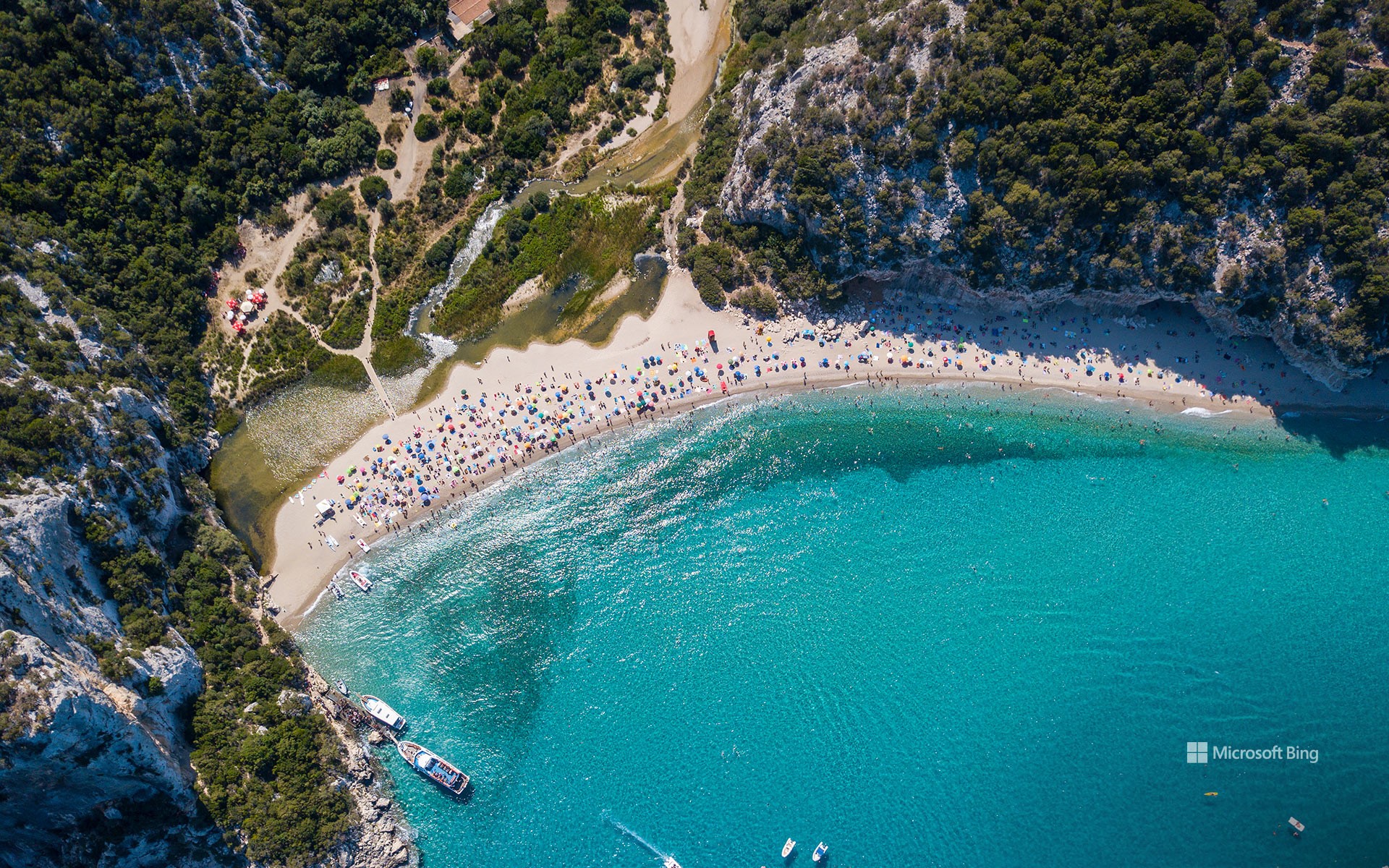
卡拉卢纳海滩, 撒丁岛, 意大利 The beach at Cala Luna, Sardinia, Italy (© guenterguni/Getty Images)
卡拉卢纳海滩, 撒丁岛, 意大利 Crisp blues, sharp views
清爽的蓝调,清晰的视野
意大利撒丁岛以其崎岖的悬崖、隐秘的海滩以及层层叠叠的蓝色海水,堪称地中海的一颗明珠。全岛海岸线长度超过1100英里。尽管岛上自然河流稀少,其中提尔索河为最长河流,撒丁岛通过水利工程建设了54座人工湖与水坝。其中最重要的两座为奥莫代奥湖与科吉纳斯湖,分别为当地的重要水源及电力供应地。
今日图中所见的卡拉卢纳海滩,位于撒丁岛东海岸的奥罗塞伊湾,在伊卢内河入海口处,坐落于月亮峡谷尽头。这片金色沙滩被海拔950英尺以上的白色石灰岩悬崖所环绕,亦是理想的攀岩胜地。这里的海水近岸浅而清澈,逐渐加深,非常适合浮潜、潜水及垂钓等活动。在当地努奥罗方言中,“月亮”一词被称为“elune”,该名称恰如其分地传达了这一迷人海湾的精髓。更添神秘气息的是,该海滩呈新月形,与其名称相呼应。数百年来,来自包内村落的牧羊人需徒步八小时才能抵达这片隐秘之地,他们将这段旅程形容为“如同走到了月亮上”。
The beach at Cala Luna, Sardinia, Italy
The island of Sardinia in Italy, with its rugged cliffs, secret beaches, and endless shades of blue, is undeniably a Mediterranean treasure. On the island's eastern coast lies Cala Luna, featured here—a beach in the Gulf of Orosei. Rising at the mouth of Rio Illune, this beach is at the end of the Codula di Luna canyon. It is a haven of golden sand, surrounded by white cliffs that rise more than 950 feet into the sky—perfect for rock climbing.
Here, the waters are shallow at first, before deepening into clear depths ideal for snorkeling, diving, and fishing. In the local Nuoro dialect, the word for 'luna,' Italian for 'moon', is rendered as 'elune,' a name that perfectly captures the essence of the beach's crescent shape.
威尼斯潟湖中的三角洲, 意大利 A delta in the Venetian Lagoon, Italy (© Dimitri Weber/Amazing Aerial Agency)
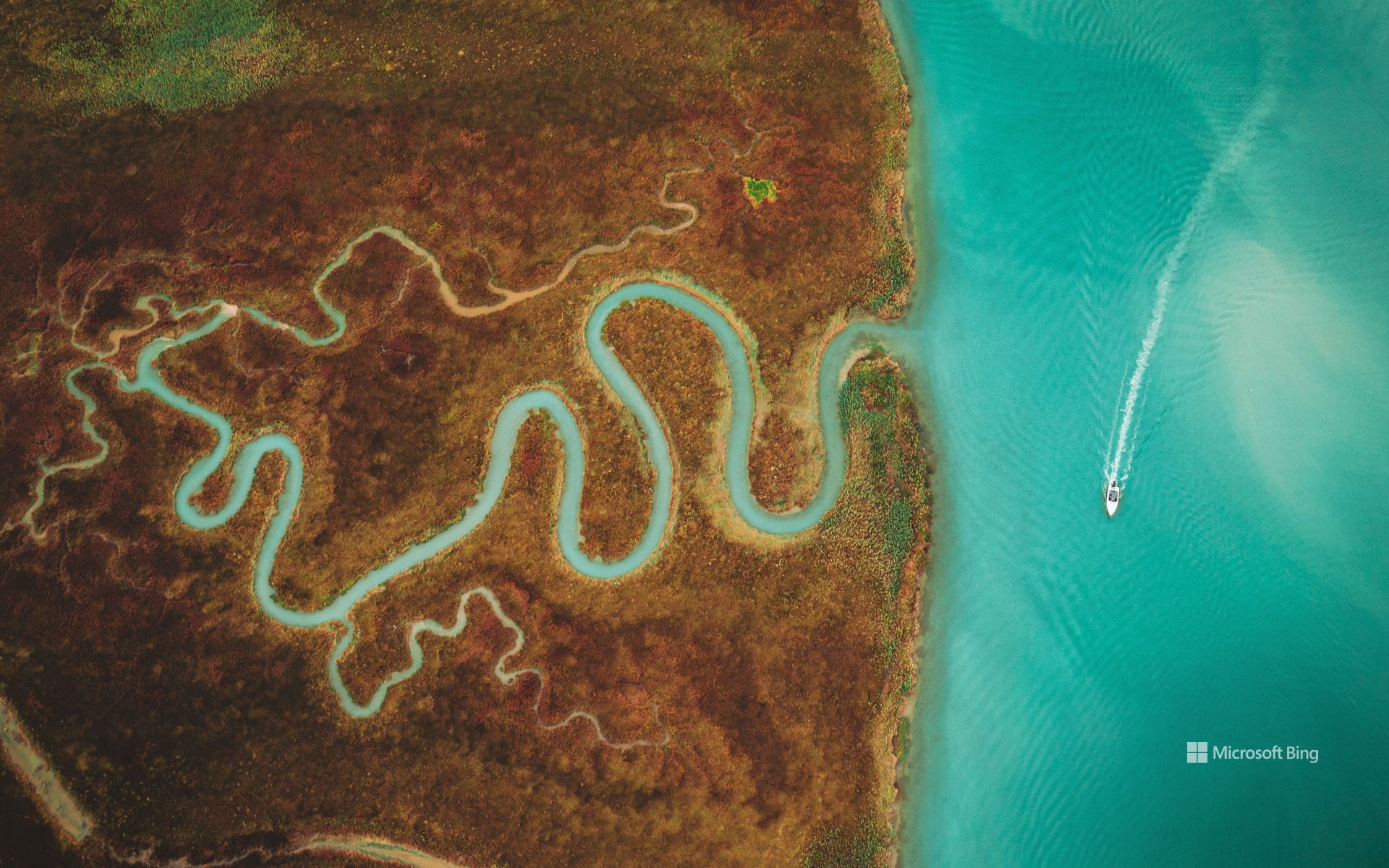
威尼斯潟湖中的三角洲, 意大利 A delta in the Venetian Lagoon, Italy (© Dimitri Weber/Amazing Aerial Agency)
威尼斯式的“甜蜜生活” The Venetian 'dolce vita'
威尼斯潟湖中的三角洲, 意大利
今天图片中的是意大利威尼斯潟湖三角洲的壮观景色。该潟湖面积超过 212 平方英里,由岛屿、泥滩、运河和沼泽组成,是整个地中海盆地最大的湿地之一。潟湖不仅是一个风景奇观,也是一个充满历史和创新的地方。它形成于上一个冰河时期之后,在西元476年西罗马帝国灭亡前后,成为人们躲避入侵的避难所。在随后的几个世纪里,这些早期的定居者开始建造最终成为标志性城市的威尼斯。
如今,这片潟湖依旧是当地居民生活的重要组成部分,支撑着渔业、旅游业,甚至发展出可持续的水产养殖业。潟湖通过三个入口与亚得里亚海相连,并因“高水位”现象广为人知:即涨潮时水位升高,导致威尼斯部分街区被淹没。从古老的避难所到现代奇观,威威尼斯潟湖展现出人与自然共同塑造一片天地的典范。
A delta in the Venetian Lagoon, Italy
Pictured here is a spectacular view of a delta in the Venetian Lagoon, Italy. Spanning over 212 square miles, this lagoon is a rich mosaic of islands, mudflats, canals, and marshes, and it's one of the largest wetlands in the entire Mediterranean Basin. The lagoon isn't just a scenic wonder—it's a place steeped in history and innovation. Formed after the last Ice Age, it became a refuge for people fleeing invasions around the time of the fall of the Western Roman Empire in 476. In the centuries that followed, those early settlers began building what would eventually become the iconic city of Venice.
Today, the lagoon is still central to local life, supporting fishing, tourism, and even sustainable aquaculture. It's connected to the Adriatic Sea by three inlets and is famous for acqua alta, or 'high water,' when tides flood parts of Venice. From ancient refuge to modern marvel, the Venetian Lagoon is a reflection of how people and nature can shape a place together.
弗拉维亚港, 苏尔西斯-伊格莱西恩特, 撒丁岛, 意大利 Porto Flavia, Sulcis-Iglesiente, Sardinia, Italy (© Marco Bottigelli/Getty Images)

弗拉维亚港, 苏尔西斯-伊格莱西恩特, 撒丁岛, 意大利Porto Flavia, Sulcis-Iglesiente, Sardinia, Italy (© Marco Bottigelli/Getty Images)
矿石与传奇 Ore and more
弗拉维亚港, 苏尔西斯-伊格莱西恩特, 撒丁岛, 意大利
大多数港口依赖延伸至海岸线的码头与吊车来进行货物装载,而波尔图弗拉维亚则完全反其道而行之。这一工程奇迹将一座石灰岩峭壁变成了撒丁岛矿石产业的门户。苏尔西斯-伊格莱西恩特的采矿历史可以追溯至几千年前,从腓尼基人、古罗马人一直延续到 20 世纪的工业繁荣时期。这里曾大量开采铅、锌、煤、硫磺、重晶石和银等矿产。但运输这些矿物却是一场噩梦:矿石需先用推车运至小船,再从小船转运至大型货船,过程缓慢、成本高昂、效率低下。
1924 年,意大利工程师切萨雷·维切利彻底改变了该地区的矿石运输方式。他将波托弗拉维亚设计成一套嵌入石灰岩峭壁的隧道和筒仓系统,使矿石能直接装入停靠在悬崖下的货船。该设施由两层隧道构成:上层设有9个矿石储仓,可容纳多达11000短吨的矿石。矿石通过重力滑道运至下层隧道,然后由传送带直接装上等候的船只。该港口以维切利的女儿弗拉维亚命名,一直使用到 20 世纪中叶采矿业衰落。如今,游客可以探索其隧道、巨大料仓,以及曾有船只停靠的装载平台,感受那曾将撒丁岛矿产送往世界各地的海风。
Porto Flavia, Sardinia, Italy
Most ports rely on docks and cranes that extend into the shoreline. Porto Flavia on the Italian island of Sardinia took a completely different approach. This engineering marvel transformed a cliff into a gateway for Sardinia's ore industry. Mining in the area has a history dating back thousands of years, from the Phoenicians and Romans to the industrial boom in the 20th century. Lead, zinc, coal, sulfur, barium, and silver were extracted from these rugged hills, but transporting them was a logistical nightmare. Ore had to be hauled by cart, loaded onto small boats, and then transferred to larger ships—a slow, costly, and inefficient process.
In 1924, Italian engineer Cesare Vecelli revolutionized ore transport in the region. He designed Porto Flavia as a system of tunnels and silos carved into a limestone cliff, allowing ore to be loaded directly onto cargo ships. The facility featured two stacked tunnel levels. The upper level could store up to 11,000 short tons of ore in nine reservoirs. Gravity-fed chutes transported the ore to the lower level, where a conveyor belt loaded it directly onto waiting ships. The port, named after Vecelli's daughter, Flavia, remained in use until mining declined in the mid-20th century. Today, visitors can explore its tunnels, massive silos, and the platform where ships once docked—soaking in the same sea breeze that once carried Sardinia's minerals to markets worldwide.
